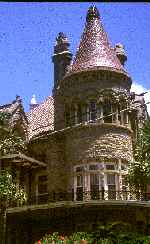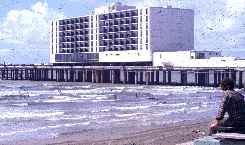GONE TO GALVESTON - Texas' Best Coastal Experience
by George Smitty"Gone to Texas" used to be a Tennessee euphemism for folks who skipped out on creditors or left to avoid the older brothers of young ladies in the family way. Today, "Gone to Galveston" offers Texas's best coastal experience.
Galveston mixes the charm, history and architecture of New Orleans' Garden District, a dash of Jean Lafitte, longer and wider beaches than you find in Hawaii, superb fishing, solid seafood and other local dining specialties in a spicy dish that costs far less than the better-known vacation areas such as Florida. Going or coming you can visit the NASA museums and drive the shores of a series of lovely bays that run behind Padre Island all the way to Mexico. There birding, fishing and just "hanging out" will warm winter visitors. Add the relaxed coastal lifestyle and it's easy to heed locals when they say, and apparently sincerely mean, "Y'all come back, hear!"
Granted any city founded by a pirate enjoys a headstart on an interesting history. Jean Lafitte led his men against all comers from his Galveston headquarters before he became semi- legitimate after his canon and skilled gunners turned the battle of New Orleans which really ended the War of 1812. His palmetto fort is gone, but Galveston's maritime history continued through the Civil War when its blockade runners helped supply the Confederacy. An incredible assortment of buildings from this classic period remain.
The reason the architectural treats of Galveston's East End, which probably peak in its Bishop's Palace, survived was the hurricane of 1900 -- "The Storm" to locals, -- that left 8,000 homeless and blew hard enough to move an 800,000 pound ship 22 miles from saltwater. Until this critical date Galveston ranked with New Orleans as the cultural and commercial centers of the Gulf coast. After "the storm" Galveston slumbered and buildings moldered away until preserved by locals who loved tradition and formed organizations such as the Galveston Historical Foundation.
Put your hotel over the Gulf. and you cut cooling costs.
Galveston architecture offers a number of solutions to the muggy coastal summers now commonplace in the latest energy efficient housing. High ceilings, wide staircases which act to funnel hot air up and out, high ground floor "basements" that move first floor possessions well above flood levels and deep overhangs and porches that shade windows add visual interests to buildings as they function efficiently even today.
The Bishop's Palace, a sandstone and granite birthday cake of a building and Texas's sole entry into the National Register of Historic Buildings, takes Victorian Gothic to rococo extremes. While this building remains the city's most celebrated landmark, Powhatan House, the Walter Gresham Home, The Cottage and Sonentheil House, all gracing the 40-square block East End Historical District between 11th and 19th and Broadway and Market do deserve tour time.
Do not overlook equally fascinating buildings such as The Open Gates, Ashton Villa and Sweeney-Royston House in the restored Silk Stocking Historical Precinct between Avenues L and N and 24th and 25th Streets. This was once known as "the Wall Street of Texas."
With numbered streets in one direction and named streets in the other, Galveston makes it easy for visitors. Some do skim Galveston in their haste to reach the beach and bay. The 17-mile long seawall that protects the city from storm waves accesses miles of wide beaches dotted with public and private fishing piers. Shoreline water slides and other attractions typical of beach towns push most visitors into bathing suits or shorts.
If you carry or rent a bike, you will find Galveston absolutely flat and most distances in the city short enough to bike or even walk. The "Lame and Lazy" can take a mini tram tour from 27th and Seawall to cover the prime sights. On the bay side of Galveston, Seawolf Park offers green lawns for picnics and breakwaters and flats where fishermen seek seatrout. Seawall park holds the only vessel in the U.S., a submarine, operated by the Japanese during World War II. Try to picnic here. The constant passage of ocean-going vessels up the Houston Ship Channel, private sail and power craft and working shrimp boats which might be netting your dinner all delight the eye. Fishermen who wade the shallows and fish live shrimp under popping corks can catch redfish and seatrout which delight the stomach too.
After a tour to work up an appetite, sample Galveston seafood. Good restaurants dot the city. Many cluster in the Silk Stocking Historical Precinct or along the wharfs. If you camp or coach, you can save with fresh shrimp, oysters, clams or fish from wharf markets. Texas Barbecue and prime beef restaurants abound. If on a budget or willing to try something offbeat, ask locals for favorites and don't be put off by appearances. The best crayfish and barbecue we found came from a battered wooden building and was served on heavy crockery plates on newspapers.
If you fish, you can catch your own dinner from the protected waters of Galveston bay and the series of bays that run east and west along the Intercoastal Waterway past Florida and past Rockport on to Mexico. Many offer prime fishing for sea trout or redfish from boats or, if you like, from your own two feet through warm, waist-deep waters. If you wade, shuffle along to scare the small rays who, if stepped on, can stick you with their spiny tails. In surf and open bays wade with long pants so you avoid sunburn and Portuguese Man-O'-war.
We fish Matagorda Bay west of Galveston, and birdwatch along the coast, which hosts many rare species from the Caribbean. To the east lies an incredible coastal tangle of shallow channels, passes and sandbars, that the Civil War blockade runners and Lafitte's pirates used so successfully. Most of these bays hold shrimp you can net from small boats. To the north of Galveston, on the way to Houston 51 miles away via Interstate 45 you might want to explore the incredible petrochemical complex along the Houston Ship Channel as well as the nearby NASA facility. Lyndon B. Johnson Space Center offers a solid museum and, if you write or call for reservations (phone 713-483-4321) you can tour the Mission Control Center and other facilities. Allow a half-day for the basic tour; a full day to see everything.
The nearby San Jacinto Monument, which commemorates the victory by Sam Houston over the Mexicans that secured eventual Texas statehood deserves a visit. The museum in monument base is worth an hour's visit, but most find the Battleship Texas (Eisenhower's flagship for D-day) that's moored nearby, more interesting.
Of course, Galveston does have drawbacks. In summer the weather grows humid and during hurricane season wise visitors head for Houston if, as is the case every three or four years, they hear weather is on the way. Fall visits avoid the worst of the humidity problem. Light clothing and planning days so more active outdoor diversions come early and late help too.
However, the real appeal of Galveston remains the locals. Never, in my 20 years of travel writing, have my wife and I found such downright helpful folks. For example, when we stopped at a tackle shop to ask about the fishing we were immediately "kidnapped" and taken out onto the bay for one of the most enjoyable fishing trips ever. We finished at the shop owner's home with fresh fried sea trout, steamed shrimp and cold cans of Lone Star. When our coach lost its transmission seal and we were stranded, locals stopped to help, drove us to the nearest garage and, when they didn't have the seal we needed, drove us 35 miles to Galveston and back to our rig. That's Texas hospitality!
While at a palm-shaded RV campground, my power connector for our air conditioner turned up missing, so the owner of the park loaned me a new one for our stay at no cost. Then, he discovered we were heading home through the frying Southwest, insisted we keep the connector until we returned the test unit RV to the manufacturer and could mail it back.
Add the waitress who, when she discovered my wife hadn't tried soft shell crabs and some other local specialties, returned to our table with "a few" samples on two plates so we could better select our dinner. When we returned several times to that modest restaurant, now burned down, we were greeted like old friends and informed of the best choices from the kitchen. Given the uniformly delightful locals, you should have little trouble finding your own spots.
Additional Information: Galveston Chamber of Commerce, 315 Tremont St., Galveston, TX 77550. Phone: 713-763-532

